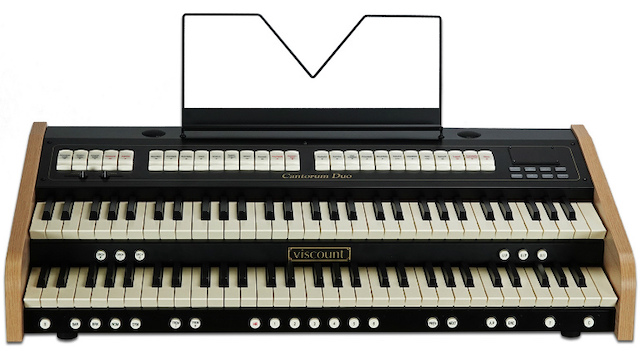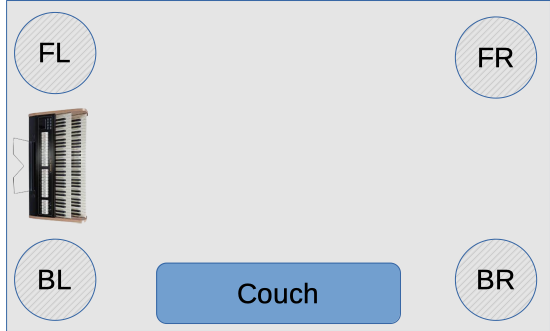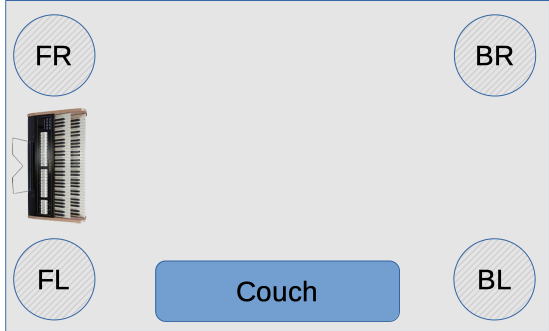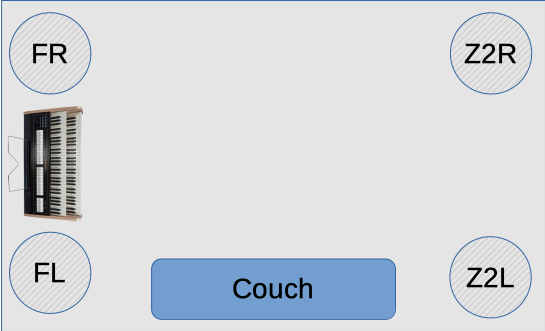My Organ
If you’ve read the planning sections, you know how I came to make my decisions for my organ plus some resources links. Here is a summary of what I’ve chosen.
Keyboard

UPDATE 2021: Viscount now has a new keyboard available, the Viscount Cantorum Trio. I haven’t heard it, but it expands the number of stops available and adds a keyboard. If I were looking for a keyboard now, I would probably have bought that instead. It is about 1/3 more than the Duo.
Pedalboard
Pedalboards are either really cheap or very expensive, depending on if they are used or new I bought a used pedalboard that had switches installed but no MIDI encoder. I wrote the software to encode it and, with a thorough scrubbing, have a pretty nice pedalboard. The only thing it needs is to have some felt replaced. It can be a bit ‘thumpy’ when you release a pedal.
Expression pedals
I wanted two pedals, so I bought the Viscount expression pedals from Thomann in Germany. Price was good and they work. They are decent and, unless you like to pump your pedals like a race car driver, I’m sure they will work for many years. When they break, I should be able to repair them. I noticed that Thomann doesn’t list but if you email them they might be able to get you a set.
Computer
EBay, thank goodness, had an HP 8300 Small Form Factor (SFF) computer at a good price with an intel I7 4 core/8 thread processor. The system can go up to 32GB and had two disk drives. The only think I did was expand it to 20GB of memory, add a video card, put in a new SSD and PCI-based M2 SSD for cache purposes. The video card cost about £10 on eBay as it is an older model. Total cost less than £250, so it was pretty good.
For sound, I found a USB output device that has up to 8 audio channels out, the Gigaport HD+. I bought it on eBay, with original box, for less than £50. I have four channels in use (2 stereo) at the moment. The controls are pretty simple, but it works well and I can easily put out 6 channels of higher resolution audio; for that I’d need a new amplifier.
Software
Given how I play now (badly), I decided to go with GrandOrgue Virtual Organ software. It installed easily, runs fairly well, and I have a number of free organs that I switch between. That is one of the biggest joys: I can change organs quickly if I get bored. I find I practice more and enjoy it more.
Using it with the Viscount can be a bit odd for a number of reasons, but the MIDI works well and there aren’t any problems between them.
I did try GrandOrgue with my Mac laptop but every time I quit the program it crashed. Not a comforting outcome.
Other equipment
MIDI routing/switch
I didn’t want to lock myself into just one keyboard/computer MIDI configuration. I want to be able to add other equipment in the future, including hardware I program myself. For that reason, I bought a mioXM midi switch. It can have 8 USB-MIDI, 4 DIN-MIDI, 12 RTP/Network-MIDI ports. It’s like a network switch that is programmable. It does have some filters and mapping ability but they tend to be fairly simple.
Sound amp
Ah, the amp. I had an old Yamaha surround sound amplifier that had dual zones. It had been replaced a few years ago so I decided to use that as my sound amp. I can route one channel of sound to the front speakers and use the second channel for the back. This works really well with the Viscount output.
Speaker arrangement
The organ placement and the sofa placement meant different speaker patterns. I ended up with a plug box in order to use them optimally. The speakers had to be setup for one of three scenarios:
- Listen to music on the sofa. This allows the amp to do some sound processing for music, but the position is the wrong for organ if I want to hear it from the organist position.

FR Front Right, FL Front Left, BR Back Right, BL Back Left
- Listen to 2 channel but processed through the surround amp for 4 channel. This produces little in the back channels when playing the organ and will probably be used the least.

FR Front Right, FL Front Left, BR Back Right, BL Back Left
- Listen to 4 channels so I can pipe different sounds to any combination of front and back. When playing organ, this will be the most used configuration.

FR Front Right, FL Front Left, Z2R Zone 2 Right, Z2L Zone 2 Left
Mixer
I have sound coming from the Viscount, computer and an old Proteus/2 module. They need to be routed and mixed to one of the two amp channels. The iMix 7.3 has three output channels and up to 10 input sources (in stereo). It also has microphone inputs which I never use.

Putting it all together
There are keyboards, synth module, amps, computers, and MIDI connections. Here is a diagram to show how all those items are connected together.

Black lines are MIDI. Red lines are audio.
Final thoughts
I’m very happy with the arrangement. I have good sound, it’s easy to use, and I have a choice of over a dozen virtual organs, plus the Viscount built-in sounds, to choose from. I can crank up the sound to extremely high levels or play softly. The arrangement has flexibility and has allowed me the pleasure of playing the organ once more.
While I would have liked three manuals, everything is a trade-off. I chose keyboards I liked more and it has proven to be a good choice. Your choices will probably differ, but that is a good as others have different needs and goals. I hope, if you do create an organ in your home, that you will post information for others to find.
We’ll never be in the heady years of the 60’s and 70’s when organs shops sold organs to loads of home owners. (Even if some were of dubious musical merit.) The digital piano tends to be a more popular choice for most. But for those that really want an organ there are options available. I hope the home organist never dies out.